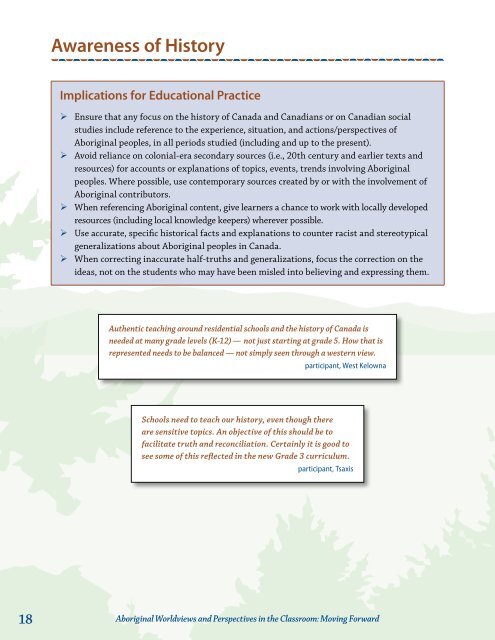Aboriginal Worldviews and Perspectives in the Classroom
1Re89x8
1Re89x8
You also want an ePaper? Increase the reach of your titles
YUMPU automatically turns print PDFs into web optimized ePapers that Google loves.
Awareness of History<br />
Implications for Educational Practice<br />
‣ ¾ Ensure that any focus on <strong>the</strong> history of Canada <strong>and</strong> Canadians or on Canadian social<br />
studies <strong>in</strong>clude reference to <strong>the</strong> experience, situation, <strong>and</strong> actions/perspectives of<br />
<strong>Aborig<strong>in</strong>al</strong> peoples, <strong>in</strong> all periods studied (<strong>in</strong>clud<strong>in</strong>g <strong>and</strong> up to <strong>the</strong> present).<br />
‣ ¾ Avoid reliance on colonial-era secondary sources (i.e., 20th century <strong>and</strong> earlier texts <strong>and</strong><br />
resources) for accounts or explanations of topics, events, trends <strong>in</strong>volv<strong>in</strong>g <strong>Aborig<strong>in</strong>al</strong><br />
peoples. Where possible, use contemporary sources created by or with <strong>the</strong> <strong>in</strong>volvement of<br />
<strong>Aborig<strong>in</strong>al</strong> contributors.<br />
‣ ¾ When referenc<strong>in</strong>g <strong>Aborig<strong>in</strong>al</strong> content, give learners a chance to work with locally developed<br />
resources (<strong>in</strong>clud<strong>in</strong>g local knowledge keepers) wherever possible.<br />
‣ ¾ Use accurate, specific historical facts <strong>and</strong> explanations to counter racist <strong>and</strong> stereotypical<br />
generalizations about <strong>Aborig<strong>in</strong>al</strong> peoples <strong>in</strong> Canada.<br />
‣ ¾ When correct<strong>in</strong>g <strong>in</strong>accurate half-truths <strong>and</strong> generalizations, focus <strong>the</strong> correction on <strong>the</strong><br />
ideas, not on <strong>the</strong> students who may have been misled <strong>in</strong>to believ<strong>in</strong>g <strong>and</strong> express<strong>in</strong>g <strong>the</strong>m.<br />
Au<strong>the</strong>ntic teach<strong>in</strong>g around residential schools <strong>and</strong> <strong>the</strong> history of Canada is<br />
needed at many grade levels (K-12) — not just start<strong>in</strong>g at grade 5. How that is<br />
represented needs to be balanced — not simply seen through a western view.<br />
participant, West Kelowna<br />
Schools need to teach our history, even though <strong>the</strong>re<br />
are sensitive topics. An objective of this should be to<br />
facilitate truth <strong>and</strong> reconciliation. Certa<strong>in</strong>ly it is good to<br />
see some of this reflected <strong>in</strong> <strong>the</strong> new Grade 3 curriculum.<br />
participant, Tsaxis<br />
18 <strong>Aborig<strong>in</strong>al</strong> <strong>Worldviews</strong> <strong>and</strong> <strong>Perspectives</strong> <strong>in</strong> <strong>the</strong> <strong>Classroom</strong>: Mov<strong>in</strong>g Forward


